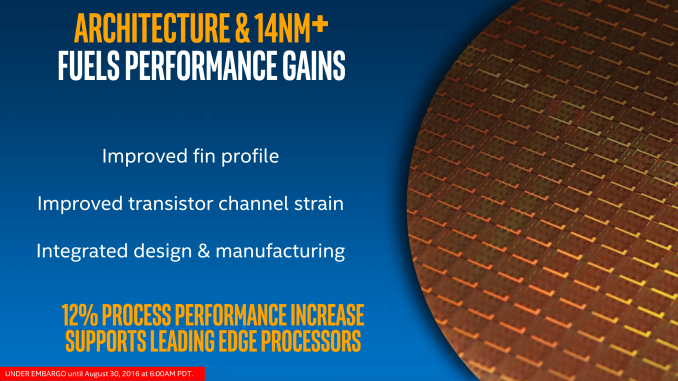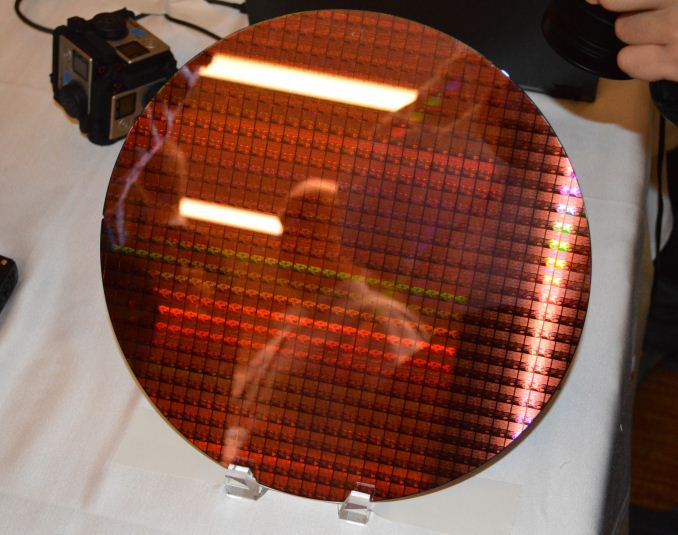Intel Launches 7th Generation Kaby Lake: 15W/28W with Iris, 35-91W Desktop and Mobile Xeon
by Ian Cutress on January 3, 2017 12:01 PM ESTA New Optimized 14nm Process: 14nm+
As originally reported in the Kaby Lake-Y/U Launch
One of the mysteries with the launch of Kaby Lake is the optimized 14nm+ process that Intel is promoting as one of the key components for the performance uptick in Kaby Lake. It’s worth noting that Intel has said nothing about caches, latencies or bandwidths. We are being told that the underlying microarchitecture for Kaby Lake is the same as Skylake, and that the frequency adjustments from the new process, along with features such as Speed Shift v2 and the new fixed function media codecs, account for the performance improvements as well as battery life increases when dealing with 4K content.
For users that speak in pure IPC, this may/may not be a shock. Without further detail, Intel is implying that Kaby Lake will have the same IPC as Skylake (which we can confirm in our reviews), however it will operate with a better power efficiency (same frequency at lower power, or higher frequency at same power) and for media consumption there will be more idle CPU cycles with lower power drain. The latter makes sense for mobile devices such as tablets, 2-in-1s and notebooks, or for power conscious users, but paints a static picture for the future of the desktop platform in January if the user only gets another 200-400 MHz in base frequencies.
However I digress with conjecture – the story not being told is on how has Intel changed its 14nm+ platform. We’ve only been given two pieces of information: taller fins and a wider gate pitch.
When Intel launched Broadwell on 14nm, we were given an expose into Intel’s latest and greatest semiconductor manufacturing lithography node. Intel at its core is a manufacturing company rather than a processor company, and by developing a mature and robust process node allows them to gain performance advantages over the other big players: TSMC, Samsung and GlobalFoundries. When 14nm was launched, we had details on their next generation of FinFET technology, discussions about the issues that faced 14nm as it was being developed, and fundamental dimensional data on how transistors/gates were proportioned. Something at the back of my brain says we’ll get something similar for 10nm when we are closer to launch.
But as expected, 14nm+ was given little extra detail. What would interest me is the scale of results or the problems faced by the two changes in the process we know about. Taller fins means less driving current is needed and leakage becomes less of an issue, however a wider gate pitch is typically associated with a decrease in transistor density, requiring higher voltages but making the manufacturing process easier with fewer defects. There is also the argument that a wider pitch allows the heat generation of each transistor to spread more before affecting others, allowing a bit more wiggle room for frequency – this is at least how Intel puts it.
The combination of the two allows for more voltage range and higher frequencies, although it may come at the expense of die size. We are told that transistor density has not changed, but unless there was a lot of spare unused silicon in the Skylake die design for the wider pitch to spread, it seems questionable. It also depends which part of the metal stack is being adjusted as well. It’s worth noting that Intel has not released die size information again, and transistor counts as a metric is not being disclosed, similar to Skylake.
Finally, there's some question over what it takes at a fab level to produce 14nm+. Though certainly not on the scale of making the jump to 14nm to begin with, Intel has been tight-lipped on whether any retooling is required. At a minimum, as this is a new process (in terms of design specifications), I think it's reasonable to expect that some minor retooling is required to move a line over to 14nm+. In which case the question is raised over which Intel fabs can currently produce chips on the new process. One of the D1 fabs in Oregon is virtually guaranteed; whether Arizona or Ireland is also among these is not.
I bring this up because of the parallels between the Broadwell and Kaby Lake launches. Both are bottom-up launches, starting with the low wattage processors followed by the bigger parts a few months later. In Broadwell's case, 14nm yields - and consequently total volume - were a bottleneck to start with. Depending on the amount of retooling required and which fabs have been upgraded, I'm wondering whether the bottom-up launch of Kaby Lake is for similar reasons. Intel's yields should be great even with a retooling, but if it's just a D1 fab producing 14nm+, then it could be that Intel is volume constrained at launch and wanted to focus on producing a larger number of small die 2+2 processors to start with, ramping up for larger dies like 4+2 and 4+4e later on.













43 Comments
View All Comments
Lolimaster - Tuesday, January 3, 2017 - link
It's the same damn skylake with a more "mature" process. Before you could call that "release new models" like FX8350 and later the 8370.Calling it a new generation is laughable. Haswell refresh got the 4790K after the initial 4770K,
marc1000 - Friday, January 6, 2017 - link
even as some specific benchmarks show 20% to 30% improvements over 2600k, when I look at gaming I loose all interest to upgrade. my computer is either idle (browsing or light use) or is gaming. to 90% of users with a "generic" profile, there is hardly any reason to leave a Sandy-bridge computer.of course, ultra-thin notebooks and other low-power equipments can put the newer cpus to good use. but wherever a 2600k can already fit, there is no reason to change it. I am keeping my 2500k for yet another cycle here... (maybe this is the result of a lack of competition for some years???)
@Ian, if possible please include a comparison of a 2500k or 2600k Sandy at 4Ghz vs the newer 7600 or 7700 processors. if this is possible of course.
limitedaccess - Tuesday, January 3, 2017 - link
So $305 is the official MSRP? This makes it cheapest mainstream i7 k series release yet?According to Anandtech's review even the first 2600k had a higher $317 MSRP, 3770k was the previous lowest at $313.
Ken_g6 - Tuesday, January 3, 2017 - link
Ars Technica says it's $350, not $305. Typo?http://arstechnica.com/gadgets/2017/01/intel-core-...
limitedaccess - Tuesday, January 3, 2017 - link
Looking at some other reviews, Tom's, Techreport and PCPer say $339.cfenton - Tuesday, January 3, 2017 - link
On the final page it says, "At the end of the day, the Core i7-7700K... has a tray price of $305. This means it will probably reach shelves around $330-$350, and we haven’t heard about a new stock cooler so it will probably come without one."So $305 is the tray price and retail will be $330-$350.
Casper42 - Tuesday, January 3, 2017 - link
> I highly suspect that the Xeon CPUs will be announced later in Q1, given that the target market for these is a little different to standard desktop processors.Late March
chucky2 - Tuesday, January 3, 2017 - link
I hope in the chipset review piece you're doing later, you address what future CPU's will be supported under series 200 socket 1151 motherboards. For example, is Intel committing to Coffee Lake support on these boards? Cannonlake? I.e. How much longevity are we going to get with these boards? Same same on the Xeon boards front for it's chipset.TEAMSWITCHER - Tuesday, January 3, 2017 - link
I'm thinking the longevity will be very short. Z270 is to Z170 ... just as ... Z97 was to Z87. Intel's 10 nm processors will probably introduce a new socket.chucky2 - Wednesday, January 4, 2017 - link
If Z270 really is like Z97, that will be a complete joke.I'm starting to wonder if the physical limits have basically been reached, and we're slowly (whether by Corp design or physics, or, some of both), just hitting the wall and this is essentially it.